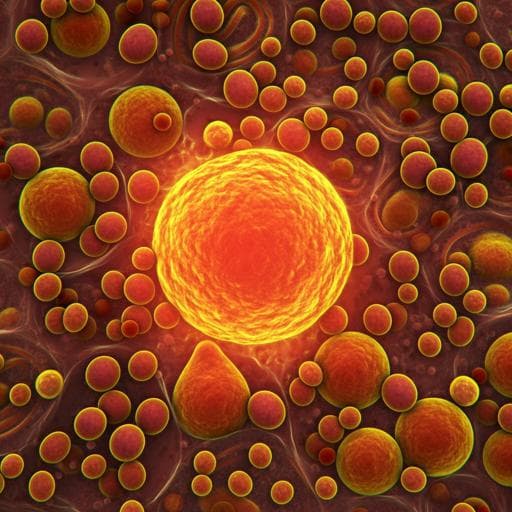
Medicine and Health
Differential routing and disposition of the long-chain saturated fatty acid palmitate in rodent vs human beta-cells
P. Thomas, C. Arden, et al.
Discover the intriguing differences in how rodent and human β-cells handle lipotoxicity from saturated fatty acids. This research by Patricia Thomas, Catherine Arden, Jenna Corcoran, Christian Hacker, Hannah J. Welters, and Noel G. Morgan reveals how palmitate routing impacts cell viability, offering insights into potential therapeutic strategies.
~3 min • Beginner • English
Introduction
The study addresses why rodent and human β-cells differ in susceptibility to lipotoxicity induced by long-chain saturated fatty acids (LC-SFA), particularly palmitate (C16:0). Elevated plasma free fatty acids, including LC-SFA, accompany insulin resistance and type 2 diabetes, and chronic LC-SFA exposure impairs β-cell function and viability in vitro. In contrast, long-chain monounsaturated fatty acids (LC-MUFA), such as oleate, are better tolerated and can mitigate LC-SFA toxicity in rodent β-cells. Mechanistic explanations for LC-SFA-induced β-cell dysfunction include disruptions in lipid homeostasis, reactive oxygen species, ER stress, mitochondrial dysfunction, and altered autophagy, often linked to specific organelles. Human EndoC-BH1 β-cells reportedly resist palmitate toxicity, prompting a direct comparison of palmitate routing and subcellular effects in rodent INS-1 vs human EndoC-BH1 β-cells to elucidate determinants of lipotoxic sensitivity.
Literature Review
Prior work demonstrates that chronic LC-SFA exposure compromises rodent β-cell viability, while LC-MUFA can be protective. Proposed mechanisms for LC-SFA lipotoxicity include intracellular lipid imbalance, oxidative stress, ER stress (PERK pathway activation), mitochondrial dysfunction, and altered autophagy, with morphological changes observed in ER, mitochondria, and lipid droplets. Human EndoC-BH1 β-cells exhibit marked resistance to palmitate, potentially due to high stearoyl-CoA desaturase (SCD) expression converting saturated to monounsaturated fatty acids. Some studies report palmitate-induced ER stress and Golgi changes in rodent β-cells, while human islet data show modest ER stress signatures exacerbated by high glucose. These mixed findings highlight cell-type and condition-specific responses and underscore the need to examine subcellular routing of palmitate and organelle morphology directly in rodent vs human β-cells.
Methodology
- Cell lines and culture: Rat INS-1E and INS-1 823/13 β-cells cultured per Asfari et al. and Hohmeier et al.; human EndoC-BH1 cells per Ravassard et al. Cultures routinely tested for mycoplasma. Cells seeded at 0.5×10^5 cells/well (12-well plates) and incubated 24 h in complete media. For imaging, cells grown on glass coverslips to ~70% confluence; for live-cell imaging in 35 mm dishes to ~30% confluence. After 24 h, media replaced with serum/BSA-free medium containing fatty acid–BSA complexes.
- Fatty acid preparation and treatments: Fatty acid–BSA complexes prepared as in prior work. Viability assays used palmitate (C16:0) at 0, 125, 250, 500, or 1000 µM for 24 h (INS-1E) or 72 h (EndoC-BH1). For protection assays, 250 µM palmitate ± 250 µM oleate (C18:1) for 24 h. Some western blot experiments also included 250 µM non-metabolizable C19:0.
- Viability assessment: Trypan Blue (0.4% in PBS) vital dye staining; experiments repeated independently at least three times.
- Confocal fluorescence microscopy: BODIPY FL C16 stock in ethanol bound to BSA/fatty acid complexes to 400 nM final concentration. After 24 h in serum/BSA-free media, cells treated with BODIPY FL C16/fatty acid complexes for 2, 6, or 24 h. Fixation in 4% paraformaldehyde. For lipid droplet identification, permeabilization with 0.2% Triton X-100, overnight incubation with anti-PLIN2 primary antibody, followed by fluorescent secondary antibodies; nuclei stained with DAPI. Golgi labeling achieved with CellLight Golgi-RFP (50 particles/cell) added 24 h after seeding; BODIPY FL C16/fatty acid complexes added 24 h later. Live-cell imaging at 37°C. Imaging performed with Leica DM18 TCS SP8 confocal microscope.
- Image analysis: ImageJ/FIJI used to quantify cell area occupied by lipid droplet-like fluorescent puncta (area of puncta/total cell area, %). Co-localization quantified using Coloc2 to compute Pearson correlation coefficients between BODIPY FL C16 and PLIN2 or Golgi-RFP. At least five cells per condition analyzed; N=3 experiments unless stated.
- Electron microscopy (EM): Cells fixed in 1% glutaraldehyde and 2% paraformaldehyde in 0.1 M sodium cacodylate (pH 7.2), processed per prior methods, imaged on JEOL JEM 1400 TEM at 120 kV. Digital images acquired with Gatan ES 1000 W CCD camera. EM assessed morphology of Golgi and intracellular membranes after 6 h treatments with vehicle, 250 µM C16:0, or C16:0 + 250 µM C18:1 (N=2 for EM).
- Western blotting: Standard protocols; antibodies detailed in supplementary materials. Targets included total and phosphorylated eIF2α and CHOP-10 (PERK pathway markers), with GAPDH as loading control. Enhanced chemiluminescence detection; densitometry with Bio-Rad GS-800, Quantity One, and ImageJ; only non-saturated blots within linear range quantified.
- ER stress positive control: Tunicamycin (5 µg/ml) for 6, 16, or 18 h depending on cell line.
- Statistics: Data reported as mean ± SD. ANOVA with Tukey’s post hoc test; significance at P<0.05. GraphPad Prism v8 used.
Key Findings
- Viability: Palmitate (C16:0) induced a dose-dependent increase in INS-1E cell death after 24 h; co-incubation with oleate (C18:1) significantly attenuated palmitate toxicity. EndoC-BH1 cells showed no increase in cell death even at 1 mM palmitate for 72 h (Fig. 1; N=3; P<0.001 vs vehicle for INS-1E at higher doses).
- Lipid droplet dynamics and routing: In EndoC-BH1 cells, BODIPY FL C16 plus palmitate produced rapid punctate cytosolic fluorescence consistent with lipid droplets (LD), with a fourfold increase in cell area covered by puncta over 24 h. In INS-1E cells, palmitate alone did not produce cytosolic puncta; addition of oleate enabled LD formation, with a threefold increase in puncta area over 24 h.
- Co-localization with LD marker: Strong co-localization of BODIPY FL C16 with PLIN2 in EndoC-BH1 cells treated with palmitate and in INS-1E cells treated with palmitate+oleate (high Pearson correlation), but not in INS-1E cells with palmitate alone.
- Golgi localization: In INS-1E cells, BODIPY FL C16 co-localized rapidly with Golgi-RFP upon palmitate exposure (high Pearson correlation), whereas no such Golgi co-localization occurred in EndoC-BH1 cells.
- Ultrastructure: EM showed distension of intracellular membranes and swollen Golgi in INS-1 cells after palmitate; these changes were absent in vehicle controls and in cells co-treated with palmitate+oleate. EndoC-BH1 cells showed no Golgi or membrane morphological changes after palmitate vs vehicle.
- ER stress markers: In INS-1E cells, neither palmitate nor oleate (alone or combined) for 6–16 h induced eIF2α phosphorylation or CHOP-10 upregulation; tunicamycin robustly induced both. In EndoC-BH1 cells, palmitate did not activate PERK-dependent ER stress; tunicamycin also failed to significantly induce eIF2α phosphorylation or CHOP-10 under the conditions tested.
- Control tracer behavior: BODIPY FL C16 alone (without exogenous palmitate) did not yield LD-like puncta in either cell line, indicating tracer distribution followed exogenous FA routing.
Discussion
The data indicate fundamental differences in how rodent vs human β-cells handle exogenous palmitate. In INS-1E cells, palmitate rapidly traffics to and accumulates in the Golgi apparatus and intracellular membranes, correlating with organelle swelling and eventual loss of viability, yet without activating PERK-dependent ER stress under the tested conditions. This suggests that ER stress is not obligatory for palmitate-induced cytotoxicity in these cells and that Golgi involvement may be a critical locus in lipotoxic injury. In contrast, EndoC-BH1 cells route palmitate into lipid droplets, avoid Golgi accumulation and morphological disruption, and maintain viability, consistent with a protective role for LD sequestration of LC-SFA. The rescue of INS-1E cells by co-supply of oleate supports the concept that promoting neutral lipid storage and LD formation redirects palmitate away from vulnerable membranes and preserves cell integrity. The lack of PERK pathway activation in both models (and tunicamycin insensitivity in EndoC-BH1) aligns with reports that ER stress signatures in β-cells are context-dependent and may require additional stressors (e.g., high glucose). The findings point to Golgi morphology/function as a potential mediator of lipotoxicity and to FA routing into LD as a protective mechanism, which may underlie species/cell-type differences in lipotoxic susceptibility and implicate enzymes such as SCD in modulating responses.
Conclusion
Palmitate exhibits distinct intracellular routing in rodent vs human β-cells: it accumulates in the Golgi of INS-1 cells, associates with organelle membrane distension, and compromises viability, whereas in EndoC-BH1 cells it is preferentially routed into lipid droplets with preserved viability. Co-treatment with oleate redirects palmitate into lipid droplets in INS-1 cells and mitigates toxicity. These observations suggest that directing LC-SFA into lipid droplets, rather than into intracellular membranes, protects β-cells from lipotoxicity. Future research should define the lipid composition changes in intracellular membranes during prolonged LC-SFA exposure, delineate the molecular determinants governing FA routing (e.g., roles of SCD and LD-associated proteins), clarify Golgi contributions to β-cell death, and test whether findings generalize to primary human islets in vivo.
Limitations
- Generalizability: Human data are from the EndoC-BH1 cell line, which may not fully recapitulate primary human β-cell behavior; authors note the need to test whether resistance to palmitate reflects the cell line or in vivo human islets.
- Methodological variability: Differences from prior studies (e.g., fatty acid composition, concentrations, incubation times, glucose conditions) may account for differing ER stress outcomes; results may be context-specific.
- ER stress assessment: Only PERK arm markers (eIF2α phosphorylation, CHOP-10) were evaluated; other stress pathways were not comprehensively assessed.
- Imaging proxies: Routing inferred using BODIPY FL C16, a fluorescent palmitate analogue, which may not fully replicate native palmitate behavior.
- EM sample size: Electron microscopy comparisons reported with limited replicates (N=2), potentially limiting morphological generalization.
- Functional readouts: Study focused on viability and morphology; effects on β-cell function (e.g., insulin secretion) were not reported.
Related Publications
Explore these studies to deepen your understanding of the subject.







